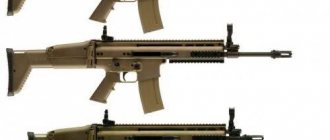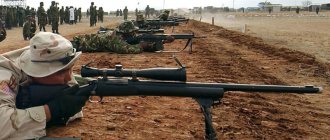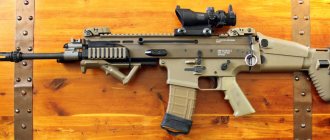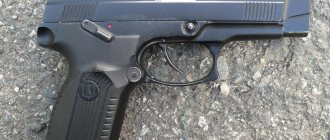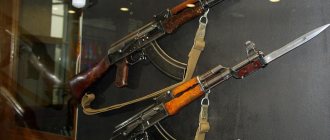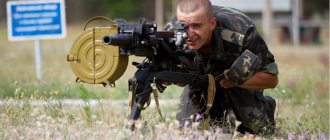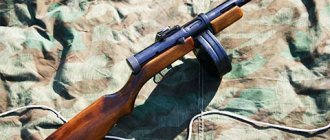Assault rifle FN SCAR (L, H) cartridge caliber 5.56 and 7.62 mm
The FN SCAR (Special Operations Combat Assault Rifle) is a weapon system developed by the American division of the Belgian company FN Herstal to participate in a competition to create a new assault rifle for USSOCOM soldiers in 2004. In December 2004, this system was declared the winner of the competition, and the rifles are currently entering service with the US Rangers.
Project evaluation
Apparently, the American military has very serious plans for the FN SCAR shooting system. It was successfully tested in the harsh conditions of Afghanistan and Iraq, where it proved itself to be a reliable and effective weapon. And this is not the only advantage of the rifle:
- High versatility. Thanks to the modular design of the FN SCAR, it can be transformed in a matter of minutes into exactly the weapon needed for a specific mission. The rifle can be equipped with a bipod, an under-barrel grenade launcher, various sighting devices, a tactical flashlight and other attachments.
- Excellent accuracy and accuracy of fire, and this applies to both single-shot shooting and automatic fire.
- Reliability. The rifle is made according to a design very similar to the Kalashnikov assault rifle. It is easy to assemble and disassemble and can be repaired even in the field. The weapon is insensitive to clogging; the use of the rifle in Afghanistan and Iraq has shown that it is not afraid of fine sand getting inside (an almost incurable disease of the M16 and its modifications).
- Ergonomics. The rifle is very comfortable, we can say that its ergonomics are at the level of the world's best small automatic weapons. You can shoot with both the left and the right hand. The safety keys and the magazine eject button are convenient and duplicated on both sides of the weapon. The rifle has an adjustable buttstock equipped with a thick rubber butt pad that partially absorbs recoil. By the way, the recoil itself is quite low, as for an automatic weapon.
If we talk about disadvantages, there are relatively few of them:
- Even a standard modification rifle is heavier than the usual M16.
- The weapon is absolutely not intended for hand-to-hand combat, which is not surprising, since the rifle was originally developed for special troops.
- FN SCAR has a fairly high price: from 2700 to 3000 dollars.
It should also be noted that the rifle’s rate of fire is slightly lower (approximately 600 rounds per minute) compared to other types of similar weapons. However, this is a very controversial drawback. Low rate of fire improves automatic fire accuracy and reduces ammo consumption.
FN SCAR assault rifle - video
At the end of 2003, the US Special Operations Command (US SOCOM) issued a request to weapons manufacturers for a new modular assault rifle for US SOCOM soldiers, designated SOF Combat Assault Rifle - SCAR (special operations combat assault rifle). . This request contained requirements that differed from the requirements put forward a little earlier by the US Army for the new promising XM8 assault rifle, currently being developed for the US by the German company Heckler-Koch. After almost a year-long competition, in December 2004, the US SOCOM command officially announced that the system presented by the American division of the famous Belgian company FN Herstal - FNH USA Inc. - won the SCAR competition. In mid-2005, new rifles received the official designations Mark 16 / Mk.16 SCAR-L and Mark 17 / Mk.17 SCAR-H. They are already being supplied to active American special forces units in Iraq and Afghanistan. It is assumed that in the foreseeable future, the Mk.16 and Mk.17 rifles will replace such “old” systems as the 5.56mm M4 carbines and M16 rifles, as well as the 7.62mm M14 and Mk rifles in the arsenal of American special forces. 25 (sniper).
FN SCAR L (Light) is an assault rifle of .223 Remington caliber, equipped with STANAG standard magazines. This option is intended to arm fighters of assault groups and second-echelon troops
The SCAR shooting system includes two basic weapon options - the “light” rifle Mk.16 SCAR-L (Light) and the “heavy” rifle Mk.17 SCAR-H (Heavy). The main differences between the SCAR-L and SCAR-H will be the ammunition used - the SCAR-L rifles are designed only for 5.56x45mm NATO cartridges (both with regular M855 bullets and with heavier Mk.262 bullets). SCAR-H rifles will use a significantly more powerful 7.62x51mm NATO cartridge as the base ammunition, with the ability to use other cartridges after replacing the necessary components (bolt, barrel, lower receiver with magazine receiver). The list of “additional” calibers for SCAR-H rifles so far only includes the Soviet cartridge 7.62x39 M43, and with this cartridge the SCAR-H rifle must use magazines from Kalashnikov AK/AKM assault rifles. In both basic configurations, SCAR rifles must have three possible configurations - the standard "S" (Standard), shortened for close combat "CQC" (Close Quarters Combat) and the sniper "SV" (Sniper Variant).
The change of variant will be carried out at the base by replacing the barrel by the soldier himself or the unit’s gunsmith. In all versions, SCAR rifles will have the same structure, the same controls, the same maintenance, repair and cleaning procedures, and the maximum possible interchangeability of parts and accessories. The interchangeability of parts between rifle variants will be about 90%. Such a modular system will provide American special forces with the most flexible weapons, easily adaptable to any task, from close combat in the city to solving sniper shooting problems at medium ranges (about 500-600 meters).
FN SCAR H (Heavy) is a rifle in .308 Winchester caliber. It is intended for snipers and markmen.
FN SCAR rifles are automatic with a gas vent engine, with a short stroke of a gas piston separate from the bolt frame, located in a gas vent block on the barrel. The rotating bolt has three lugs; locking is carried out behind the breech of the barrel. The receiver consists of two halves - the upper one, in which the barrel and bolt group are installed, and the lower one, in which the magazine receiver and the firing mechanism module are made. The lower half of the receiver is made of polymer, the upper half is made of aluminum. The halves are connected to each other by two cross pins at the front and rear. The barrels are replaceable and are attached to the upper half of the receiver with two transverse bolts. Changing the barrel requires a minimum of tools and takes a few minutes.
The trigger mechanism has a double-sided fire/safety mode selector lever, which allows firing single shots or bursts. There is no queue length limiter in the FN SCAR trigger. The cocking handle can be installed on both the left and right sides of the weapon, for which there are corresponding slots on both sides of the upper part of the receiver.
Partial disassembly of the FN SCAR L rifle with a standard and short barrel
The rifle is equipped with a bolt stop mechanism that stops the bolt in the open position when all the cartridges in the magazine are used up. The shutter stop is turned off using a button on the left side of the weapon, above the magazine receiver. The magazine release button is located on both sides of the weapon. The cartridges are ejected through a window on the right side of the receiver, behind which there is a spent cartridge deflector, allowing the rifle to be fired from the left shoulder.
On the upper surface of the receiver, as well as on the forend on the sides and bottom, there are Picatinny rail type guides for attaching sights and other accessories. The rifle is standardly equipped with removable open sights, consisting of a folding diopter rear sight, adjustable for range, and a folding front sight. In addition, any day or night sights with appropriate brackets can be installed on the rifle. The buttstock of all variants of the FN SCAR rifle folds to the side. It is made of plastic and can be adjusted in length to suit each individual shooter. Additional accessories include a new 40mm under-barrel grenade launcher and a removable foregrip, which houses a small bipod for prone firing.
Army and weapons
The FN SCAR (Special Operations Forces Combat Assault Rifle) is a modular assault rifle created by the Belgian company FN Herstal for the US Special Operations Command (SOCOM) and meets the requirements of the competition to create a new machine gun for USSOCOM soldiers. The rifle family includes two main types: the SCAR-L, a lightweight version chambered for the 5.56x45mm NATO cartridge, and the SCAR-H. heavy, chambered for NATO 7.62x51 mm cartridge. Both options provide for the installation of an extended or shortened barrel for close combat.
Small-scale production of the FN SCAR began in June 2007. After some hesitation, the rifles began to enter the armed forces in April 2009. That same year, the 75th Ranger Regiment received its first 600 rifles. SOCOM currently plans to cancel its acquisition of the Mk 16 SCAR-L and retire them by 2013. However, the American command plans to receive upgrade kits for the Mk 17 (SCAR-H) for the 5.56 mm caliber and, accordingly, make up for the deficiency of the Mk 16. Today, the SCAR is one of the best systems to replace the M4 rifle.
As mentioned above, the SCAR is available in two, “light” (SCAR-L, Mk 16 Mod 0) and “heavy” (SCAR-H, Mk 17 Mod 0), trim levels. The lightweight version is designed to fire 5.56x45mm NATO rounds and uses STANAG magazines from the M16 rifle. The heavy SCAR is designed for the more powerful 7.62x51 mm NATO cartridge, so a detachable 20-round magazine was specially created for it. For long-range and close-range combat conditions, elongated and shortened barrels are produced, respectively. Initially, it was assumed that the SCAR-H rifles could also be loaded with M43 Kalashnikov 7.62x39 mm or 6.8x43 mm Remington SPC cartridges, but FN Herstal is no longer considering this possibility.
Before the American command abandoned the light Mk 16 Mod 0 models, they entered service with the troops to replace the M4A1, Mk 18 CQBR and Mk 12 SPR rifles in service. In turn, the Mk 17 Mod 0 type replaced the M14 and Mk 11 sniper rifles.
The Mk 20 sniper rifle was created on the basis of the Mk 17 Mod 0. More than 60% of its parts are unified with the basic model of the machine gun. It includes an elongated and reinforced receiver, a reinforced barrel profile to reduce its vibrations and improve shooting accuracy. The rifle's trigger mechanism allows only single fire.
On the top of the aluminum receiver, SCARs have a permanent Picatinny rail, two removable rails on the side and one MIL-STD-1913 rail on the bottom. A polymer stock is attached to their receiver, to which is attached a plastic pistol grip from the M16, a window for the magazine receiver with a button for removing it. The front sight can be folded down for unobstructed use of optics and other accessories.
The rifle's mechanism is similar to the M1 carbine and works on the principle of removing powder gases through a transverse hole in the barrel wall, while the gas piston is similar to the pistons of the Stoner 63 or Heckler & Koch G36 assault rifles.
SCAR rifles are manufactured at the facilities of the Belgian arms company FN Herstal in Columbia, South Carolina, USA. At the end of 2008, Fabrique Nationale began producing semi-automatic rifles 16S (light) and 17S (heavy). Designed for law enforcement and hunters, these examples are manufactured in Eerstal, Belgium and imported by FNH USA, a subsidiary of Fredericksburg, Virginia. The Americans slightly modernized her store to comply with the US Code.
Machine guns (top to bottom): SCAR-L (Mk 16 Mod 0) and SCAR-H (Mk 17 Mod 0) (ill. Fabrique Nationale de Herstal USA).
Machine guns with a shortened barrel (from top to bottom): SCAR-L (Mk 16 Mod 0) and SCAR-H (Mk 17 Mod 0) with an FN40GL underbarrel grenade launcher.
HAMR IAR
In 2008, a variant of the FN SCAR modular rifle with thermal adaptation (Heat Adaptive Modular Rifle) appeared. He was one of four contenders in the Infantry Automatic Rifle competition. According to the requirements of the US Marine Corps, the infantry assault rifle must be light and convenient for working in a group. This model differed from existing SCAR rifles in that it combined the operations of locking the bolt (the bolt is directed forward/loading a cartridge) and unlocking the bolt (the bolt is directed backward/there is no cartridge in the chamber), as well as automatically moving it to the unlocked position when the barrel overheats. According to the results of the competition, the Marine Corps was to purchase 6,500 machine guns within five years. Ultimately, the SCAR gave way to the Heckler & Koch HK416 assault rifle, which was then renamed the M27.
FNAC
This model (AC - Advanced Carbine) took part in the “Individual Carbine” competition, designed to identify a receiver for the M4 rifle. The FNAC assault rifle is very similar to the SCAR Mk 16 Mod 0, however it has a 167g reduction in weight, has an M9 knife mount, which is missing on the Mk 16, and a non-reciprocating charging handle (it remains in place during the gas piston stroke) .
Improved underbarrel grenade launcher
In 2004, the FN40GL (Mk 13 Mod 0) 40mm grenade launcher was developed as an addition. It is based on the GL1 grenade launcher for the F2000 assault rifle. The FN40GL is available for “light” and “heavy” models of assault rifles, and is characterized by a self-cocking trigger mechanism and a side-hinging barrel. This model has some advantages over its predecessor M203. There is no need to cock the hammer if the grenade fails to fire, and longer grenades can be used. Like the M203, the FN40GL grenade launcher is based on the high-low pressure principle, where a small part of the barrel withstands high pressure and ignites the powder, while the rest of the low-pressure barrel serves to guide the grenade.
In 2007, the US Army held a competition between the M4, FN SCAR, HK416 rifles and the previously rejected HK XM8. Ten copies of each model took part. Of these, 6,000 shots were fired into the air under “extremely crowded conditions.” According to the results of the competition, SCAR showed 226, XM8 – 127, HK 416 – 233 and M4 – 882 failures. As a rule, they were caused by a violation of the supply of cartridges from the magazine.
Adoption
In 2004, the SCAR was adopted as a combat assault rifle for special operations forces. Based on the results of 5 weeks of field testing conducted in late 2008, the MK 16, MK 17 and MK 13 were officially recognized as effective and suitable for operations. Already in April 2009, these models entered the troops. At the end of October 2010, SOCOM approved mass production of the Mk 20 sniper rifle. In mid-May 2011, its active use began.
Refusal to purchase Mk 16
On June 25, 2010, SOCOM, citing a lack of funding and the lack of significant differences with other 5.56 mm caliber rifles, announced its refusal to purchase Mk 16 assault rifles. Unspent funds are expected to be spent on the Mk 17 7.62x51 mm caliber and the Mk 20 sniper version. However, FN Herstal noted that the Mk 16 assault rifle will remain in service with SOCOM, and the choice between 7.62 and 5.56 mm caliber will be made by individual departments (SEALs, Rangers, Special Forces, MARSOC and AFSOC) for individual tasks .
For the military
SCAR-L Mk 16 Mod 0 – 5.56 mm NATO assault rifle;
Mk 16 CQC (Close Combat Rifle) – 10 inch (354 mm) barrel; 3.04 kg; length when folded - 787/533 mm Mk 16 Standard - barrel 14 inches (495 mm) long; 3.29 kg; 889/635 mm Mk 16 LB (long barrel) - 18 inch (637 mm) barrel; 3.49 kg; 990/736 mm SCAR-H Mk 17 Mod 0 - 7.62 mm NATO Mk 17 CQC (Close Combat Rifle) - 10 inch (354 mm) barrel; 3.49 kg; 889/635 mm Mk 17 Standard – 16-inch (566 mm) barrel; 3.58 kg; 965/711 mm Mk 17 LB (long barrel) – 20 inch (708 mm) barrel; 3.72 kg; 1067/813 mm Sniper Support Rifle (SSR) Mk 20 Mod 0 – 7.62 mm NATO caliber sniper rifle; 4.85 kg; 1080/1029 mm Experimental samples
HAMR IAR (FN SCAR modular rifle with thermal adaptation) FNAC (FN advanced carbine) - 5.56 mm NATO assault rifle.
For hunters
SCAR 16S - civilian version of 5.56 mm caliber, semi-automatic only SCAR 17S - civilian version of 7.62 mm caliber, semi-automatic only Ammunition: 5.56x45 mm NATO (SCAR-L);
7.62×51 mm NATO (SCAR-H) Mechanics: gas engine with a short stroke of a gas piston separate from the bolt frame Rate of fire: 625 rounds/min; Muzzle velocity: SCAR-L (870 m/s M855 and 800 m/s Mk 262), SCAR-H (714 m/s M80); Sighting range: SCAR-L (for short, standard and long modifications) - 300, 500 and 600 meters, respectively; SCAR-H (for short, standard and long modifications) - 300, 600 and 800 meters, respectively; Feed: STANAG (SCAR-L) detachable magazine and 20-round detachable magazine for SCAR-H/SSR Used by
France: RAID and COS police departments; Mexico: Federal Police use SCAR-L and SCAR-H models; Peru: In 2009, the Peruvian Navy acquired the SCAR-H assault rifle; Poland: Government Protection Bureau; United States: American Army.
——
en.wikipedia.org/wiki/FN_SCAR
Performance characteristics of FN SCAR
— Years of operation: since 2005 (officially), since 2007 (actually) — Adopted into service: 2009 — In service: US special forces — Manufacturer: FNH USA Inc — Options: Mk.16 SCAR-L (Light), Mk .17 SCAR-H (Heavy)
Weight FN SCAR
— 3.19 (SCAR-L CQC); 3.3 (SCAR-L STD); 3.49 (SCAR-L SV); 3.512 (SCAR-H CQC); 3.621 (SCAR-H STD); 3.72 (Scar-H SV) without magazine
Dimensions FN SCAR
Length, mm: 796/548 (SCAR-L CQC); 890/642 (SCAR-L STD); 991/737 (SCAR-L SV); 886/638 (SCAR-H CQC); 960/712 (SCAR-H STD); 1067/813 (SCAR-H SV) with stock unfolded/folded Barrel length, mm: 253 (SCAR-L CQC); 351 (SCAR-L STD); 457.2 (SCAR-L SV); 330 (SCAR-H CQC); 406 (SCAR-H STD); 508 (SCAR-H SV)
FN SCAR cartridge
— 5.56x45mm NATO (SCAR-L); 7.62x51mm NATO (SCAR-H); 7.62x39 mm (SCAR-H, after replacing several parts)
Caliber FN SCAR
- 5.56 mm (SCAR-L); 7.62 mm (SCAR-H)
FN SCAR rate of fire
— 625 (SCAR-L), (SCAR PDW), 600 (SCAR-H) rounds/min
FN SCAR bullet speed
— SCAR-L: 870 (M855 cartridge), 800 (Mk 262 cartridge); SCAR-H: 802 (M80 cartridge) m/s
Sighting range of FN SCAR
— SCAR-L: 400 m (CQC), 600 m (STD), 800 m (SV); SCAR-H: 500 m (CQC), 700 m (STD), 900 (SV)
FN SCAR magazine capacity
— detachable box magazine for 30 (SCAR-L); 20 (SCAR-H) rounds
Maximum range, m: 900 (SCAR-H SV) Sight: removable diopter, there is a Picatinny rail for mounting various sights Operating principles: removal of powder gases, rotary bolt
Other options
FN SCAR SSR Mk.20 Mod.0 (eng. Sniper Support Rifle - sniper support rifle) is a semi-automatic sniper rifle, adopted by the US Special Operations Command (US SOCOM) forces in 2010 under the designation Mark 20 (Mk.20 Mod. 0). The rifle can conduct single fire and two-shot bursts.
FNAC (Advanced Carbine) is a simplified version of the Mk 16 Standard. The main difference is the lack of the ability to quickly change the barrel. The front sight is mounted on the receiver, whereas the Mk 16 has a bayonet mount at the junction of the gas tube and the barrel (not present on the Mk 16), and the loading handle is stationary during firing. The FNAC is also somewhat lighter than the Mk 16: 6.9 lb (3.1 kg) and 7.2 lb (3.3 kg), respectively (the weight of the weapon without ammunition is indicated for both options).[19] Participated in the US Army competition to replace the M4 carbine, but the competition was closed before the winner was announced.
FN HAMR (Heat Adaptive Modular Rifle - temperature adaptable modular rifle) - An innovative development of the FN company. By default, the FN HAMR, like most assault rifles, fires from a closed bolt, which contributes to the accuracy of fire. If, during firing, the temperature of the barrel exceeds a certain limit, the weapon automatically switches to firing mode from an open bolt (as is typical for most machine guns), which promotes better cooling of the internal space of the receiver and allows firing in long bursts. Thus, the HAMR combines the features of both automatic rifles and light machine guns. Switching between these modes is carried out by a special block located under the barrel. Caliber 5.56 mm, barrels 16 inches (410 mm) and 18 inches (460 mm) long.
In 2008, HAMR participated in the Infantry Automatic Rifle competition for the US Marine Corps, which was won by the Heckler-Koch HK416 rifle (adopted into service under the designation M27).
FN SCAR PDW (Personal Defense Weapon) is a variant intended for arming the crews of combat vehicles, helicopters, technical specialists, and the like. The main difference from the basic modifications of the SCAR is a short barrel length of 6.75 inches (170 mm) and a simplified, non-adjustable, retractable shoulder rest. Length with shoulder rest extended 24.9 inches (630 mm), with rest folded - 20.5 inches (520 mm), weight empty 5.5 pounds (2.5 kg), effective firing range - 200 m.
FN CSR-20 (Compact Sniper Rifle - compact sniper rifle) is a self-loading sniper rifle with a barrel length of 20″ (508 mm) chambered for 7.62×51 mm NATO cartridge.
Photo FN SCAR
Similar
AK-47 assault rifle cartridge caliber 7.62 mm. Device. Rate of fire
AK-74 assault rifle cartridge caliber 5.45 mm. Device. Rate of fire
Dragunov SVD sniper rifle caliber 7.62 mm. Device
AKS-74U assault rifle cartridge caliber 5.45 mm. Device. Weight
Mauser K96 pistol cartridge caliber 7.63 and 9 mm. Device
Pistol Walter PP / PPK cartridge caliber 7.65 and 9 mm. Device
Pistol Yarygin PYa Grach cartridge caliber 9 mm. Device
DShK machine gun cartridge caliber 12.7 mm. Device. Rate of fire
Luger pistol R.08 Parabellum cartridge caliber 9 mm. Device
Pistol PM cartridge caliber 9 mm. Rate of fire. Dimensions. Bullet speed. Sighting range
Self-loading shotgun Saiga-12 cartridge, caliber. Device
Maxim machine gun cartridge caliber 7.62 mm. Device. Weight
PPSh-41 Shpagina submachine gun cartridge caliber 7.62 mm
APS Stechkin pistol cartridge caliber 9 mm. Device
Nagan system revolver cartridge caliber 7.62 mm. Device
Kalashnikov PK machine gun and PKM cartridge caliber 7.62 mm. Device
Simonov carbine SKS-45 cartridge caliber 7.62 mm. Device
Rifles and carbines Mauser 98 caliber 7.92 mm. Device
PPS-42 and PPS-43 Sudaev submachine gun cartridge caliber 7.62 mm
Pistol Walter P38 cartridge caliber 9 mm. Device
MP-40 German submachine gun cartridge caliber 9 mm. Device
VSS Vintorez sniper rifle caliber 9 mm. Device
Submachine gun PP-91 Kedr cartridge 9 mm caliber. Device
Light machine gun RPK-74 cartridge caliber 5.45 mm. Device
Pistol Glock 17 cartridge caliber 9 mm. Device
Makarych, Izh-79-9T, MR-79-9TM, MP-80-13T traumatic pistol
AK-12 assault rifle cartridge caliber 5.45 mm. Device. Weight
Mosin rifles and carbines Three-line caliber 7.62 mm
PMM Makarov pistol modernized 12 rounds. Device
Revolver Colt Single Action Army (SAA) Peacemaker. Device
Machine gun PKP Pecheneg cartridge caliber 7.62 mm. Device
Sniper rifle VSSK Exhaust caliber 12.7 mm. Device
Beretta pistol 92 cartridge caliber 9 mm. Device
TT - Tokarev pistol cartridge caliber 7.62 mm. Device
Submachine gun PP-19 Bison cartridge caliber 9 and 7.62 mm. Device
Sniper rifle SV-98 caliber 7.62 mm. Device
Vladimirov KPV machine gun cartridge caliber 14.5 mm. Device
ASH-12 assault rifle cartridge caliber 12.7 mm. Device. Rate of fire
PSM pistol cartridge caliber 5.45 mm. Device
Pistol Colt M1911A1 cartridge caliber 45. Device
Smith-Wesson revolver Russian cartridge, caliber 10.67 mm. Device
Degtyarev DP-27 light machine gun, 7.62 mm caliber cartridge. Device
Shotgun Mossberg 500 Cartridge. Dimensions. Rate of fire. Sighting range
Pistol USP Heckler und Koch cartridge, caliber. Device
Thompson submachine gun cartridge caliber 11.43 mm. Device
Hunting carbine OSK-88 (SVT-40) caliber 7.62 mm. Device
AS Val silent automatic cartridge caliber 9 mm. Device
Submachine gun PP-19-01 Vityaz cartridge 9 mm caliber. Device
Machine gun Kord cartridge caliber 12.7 mm. Device. Weight. Sighting range
Osa - traumatic pistol cartridge, caliber. Device
AK-9 assault rifle cartridge caliber 9 mm. Device. Rate of fire
Degtyarev RPD light machine gun, 7.62 mm caliber cartridge. Device
Automatic OTs-14 Groza cartridge caliber 9 mm and 7.62 mm. Device
Czech pistol CZ-75 (modifications). Device
Browning pistol 1903 cartridge caliber 9 mm. Device
Sniper rifle OSV-96 caliber 12.7 mm. Device
FN P90 submachine gun cartridge caliber 5.7 mm. Device
Submachine gun OTs-02 Cypress cartridge caliber 9 mm. Device
Sniper rifle ASVK Kord caliber 12.7 mm. Device
Automatic AEK-971 Cartridge. Caliber. Device. Rate of fire
Steyr AUG assault rifle (A1, A2, A3) cartridge caliber 5.56 mm
AK series 100 assault rifles. Modifications. Device. Weight. Dimensions
Uzi submachine gun. Cartridge. Caliber. Rate of fire
Pistol SR1M Gyurza cartridge caliber 9 mm. Device
Pistol GSh-18 cartridge caliber 9 mm. Device
SVDK sniper rifle caliber 9.3 mm. Device
Automatic SR-3M Whirlwind cartridge caliber 9 mm. Device
Machine gun NSV-12.7 Utes cartridge, cal. Device. Weight
Kalashnikov RPK light machine gun cartridge caliber 7.62 mm. Device
Sniper rifle VSK-94 caliber 9 mm. Device
Vostok-1 (Jorge-3M) 9mm caliber traumatic pistol. Device
Degtyarev PPD submachine gun cartridge caliber 7.62 mm
English sniper rifle L96A1 cartridge, caliber
M1 Garand rifle cartridge caliber 7.62 mm. Device
Desert Eagle pistol. Device
Smith-Wesson revolver (modifications). Device
Automatic rifle HK G36 (E, K, C, KE) cartridge caliber 5.56 mm
Pistol P-96 cartridge caliber 9 mm. Device. Rate of fire
Pistol GP35 Browning High Power cartridge, caliber. Device
Assault rifle FN SCAR (L, H) cartridge caliber 5.56 and 7.62 mm
Revolver Lefoshe M1856 cartridge caliber 11 mm. Device
Submachine gun PP-90 cartridge caliber 9 mm. Device
AN-94 Abakan automatic Nikonov cartridge caliber 5.45 mm. Device
Submachine gun PP-2000 cartridge caliber 9 mm. Device
Mauser pistol HSc cartridge caliber 7.65 and 9 mm. Device
M16 automatic rifle cartridge caliber 5.56 mm. Device
Fedorov assault rifle cartridge caliber 6.5 mm. Device. Rate of fire
Pistol Baltiets cartridge caliber 7.62 mm. Device
Strizh pistol cartridge caliber 9 mm. Device. Weight. Sighting range
Browning pistol 1910 cartridge caliber 7.65 and 9 mm
Silent pistol PSS Vul cartridge caliber 7.62 mm. Device
Pistol SIG-Sauer P226 cartridge caliber 9 mm. Device
Pistol OTs-27 Berdysh cartridge caliber 7.62 mm and 9 mm. Device
AK-107 assault rifle cartridge caliber 5.45 mm. Device. Rate of fire
OTs-44 sniper rifle, caliber 12.7 mm. Device
German machine gun MG3 cartridge caliber 7.62 mm. Device
Self-loading shotgun Browning Auto-5 cartridge, caliber. Device
Submachine gun AEK-919K Kashtan cartridge caliber 9 mm. Device
PB pistol silent cartridge 9 mm caliber. Device
Pistol OTs-33 Pernach cartridge caliber 9 mm. Device
Hunting carbine KO-98 cartridge caliber 7.92 mm. Device
TK (Korovin pistol) caliber 6.35 mm. Device. Weight. Dimensions
Underwater assault rifle APS cartridge caliber 5.66 mm. Device
Pistol OTs-21 Malysh cartridge caliber 9 mm. Device
American M60 machine gun, 7.62 mm caliber cartridge. Device
MTs-116M sniper rifle, caliber 7.62 mm. Device
Automatic 9A-91 cartridge caliber 9 mm. Device. Rate of fire
Submachine gun PP-93 cartridge caliber 9 mm. Device
VAG-73 - Gerasimenko pistol. Device. Weight. Dimensions
Cordon-5 is a traumatic pistol. Device. Weight. Dimensions
Goryunov SG-43 heavy machine gun cartridge caliber 7.62 mm. Device
Webley revolver cartridge, caliber. Device. Dimensions. Weight
Machine gun AEK-999 Badger cartridge caliber 7.62 mm. Device
RP-46 machine gun, 7.62 mm caliber cartridge. Device. Rate of fire
Sniper rifle VS-8 cartridge caliber 8.6 mm. Device
Slostin machine gun cartridge caliber 7.62 mm and 14.5 mm. Device
Assault rifle Tavor TAR-21 cartridge caliber 5.56 and 5.45 mm
Submachine gun SR-2 Veresk cartridge caliber 9 mm. Device
Lancaster pistol cartridge caliber 12.1 mm. Device. Rate of fire
Submachine gun PP-90M1 cartridge caliber 9 mm. Device
Underwater pistol SPP-1M. Device. Weight. Dimensions
Traumatic pistol MP-461 Guard. Device. Weight. Dimensions
Lebel rifles and carbines are cartridgeed in 8 mm caliber. Device
Automatic A-91 cartridge caliber 7.62 mm. Device. Rate of fire
M14 automatic rifle cartridge caliber 7.62 mm. Device
Revolver Smith & Wesson Model 10 Military & Police
Automatic rifle FN FAL cartridge caliber 7.62 mm. Device
Submachine gun STEN MK 2. Device. Weight. Dimensions
Traumatic pistol IZH-78-9T Chain mail cartridge caliber 9 mm
Leader-M traumatic pistol 11.43×32T. Device. Weight. Dimensions
Ingram M10 and M11 submachine gun. Device. Weight. Dimensions
Pistol Steyr M9-A1 cartridge caliber 9 mm. Device. Weight
Pistol OTs-23 Dart cartridge caliber 5.45 mm. Device
Berthier rifles and carbines caliber 8 mm. Device
Automatic shotgun USAS-12 cartridge caliber 18.5 mm
Sniper rifle VS-121 caliber 7.62 mm. Device
Traumatic pistol MP-353 cartridge, caliber 11.43 mm
Tiss machine gun cartridge caliber 9 mm. Device. Rate of fire
Traumatic pistol MP-355 cartridge caliber 9 mm. Device
Automatic double-medium ADS cartridge caliber 5.45 mm. Device. Rate of fire
Traumatic pistol MP-81 cartridge caliber 9 mm. Device
Pistols Zastava 70 and 70(k), cartridge caliber 7.65 or 9 mm. Yugoslavia
Sniper rifle GALATZ (Galil) cartridge caliber 7.62 mm
Pistol MP-444 Bagheera cartridge caliber 9 mm. Device
Revolver Colt New Army / Navy. Device. Bullet speed. Sighting range
Type 64 is a Japanese automatic rifle. Device
Comments
+1 trork 11/20/2017 7:42 pm I understand everything... but look at the picture with the disassembly of this device. and tell me, maybe I’m seeing something wrong - where is the SHORT STROKE of the gas piston?! This is a classic AK bolt kit!))) one-piece piston with frame, that is, a LONG stroke!!! only the lever was moved to a separate recess, moved from the frame to the piston rod - and that’s it! no, they improved it, the disassembly method was radically altered, not without that, of course - but why is there a SHORT stroke in the article? where is it short??? explain, otherwise my mind is already going beyond my mind...
Reply | Reply with quote | Quote
Update list of comments
Creation Story
In 2003, the South American Special Operations Forces Command announced the start of a competition to create a new assault rifle with a modular design.
A year later, the favorite of this competition was announced; it became the South American division of the famous Belgian company FN Herstal. It must be emphasized that at first most professionals preferred the XM-8 assault rifle, developed by the German company Heckler-Koch.
In 2005, a brand new rifle began to be supplied to US special forces units operating in Iraq and Afghanistan. FN SCAR was made in 2 modifications: Mk.16 SCAR-L and Mk.17 SCAR-H. The South American military planned that in the future this weapon would replace such well-deserved but obsolete standards as the M4, M16, M14 and Mk. 25.
In the summer of 2007, several assault rifles were tested in the United States: the German-American XM8, the German NK 416 and the American-Belgian FN SCAR. It was planned that in the future one of these rifles should replace the M4 automatic carbine. Tests were carried out in harsh desert conditions. Among the presented samples of weapons, the FN SCAR assault rifle proved to be the most ideal.
In 2009, it was adopted by the American army.
Already at this moment, a trend can be noted that the FN SCAR rifle complex, initially developed for special units, is gradually becoming the main weapon of the US Army. There is a rearmament plan, according to which the “antique” M16 rifle, which served the South American military for more than 50 years, will be gradually replaced by the FN SCAR.
